Australian Industrial Relations: Fair Work Act Analysis
VerifiedAdded on 2020/03/02
|10
|2131
|265
Report
AI Summary
This report provides an analysis of the Fair Work Act 2009, examining its significant impact on Australian industrial relations. It traces the evolution of employment relations from the servant-master model to the current employer-employee dynamic, highlighting the influence of institutionalism and the introduction of the Act. The report covers key features of the Act, including good faith bargaining, enterprise agreements, modern awards, unfair dismissal provisions, and minimum wage adjustments. It compares the FWA to the previous Work Choices legislation, focusing on the changes in employee representation and the role of the Fair Work Ombudsman. The analysis discusses the complexities of the new system, the potential for disputes in areas like unfair dismissal, and the overall impact on employees and employers. The report concludes that while the FWA did not completely restore the pre-Work Choices form of regulation, it introduced several new aspects and retained some of the fundamental areas incorporated by Work Choices. The study also includes several references of the topic from various authors.
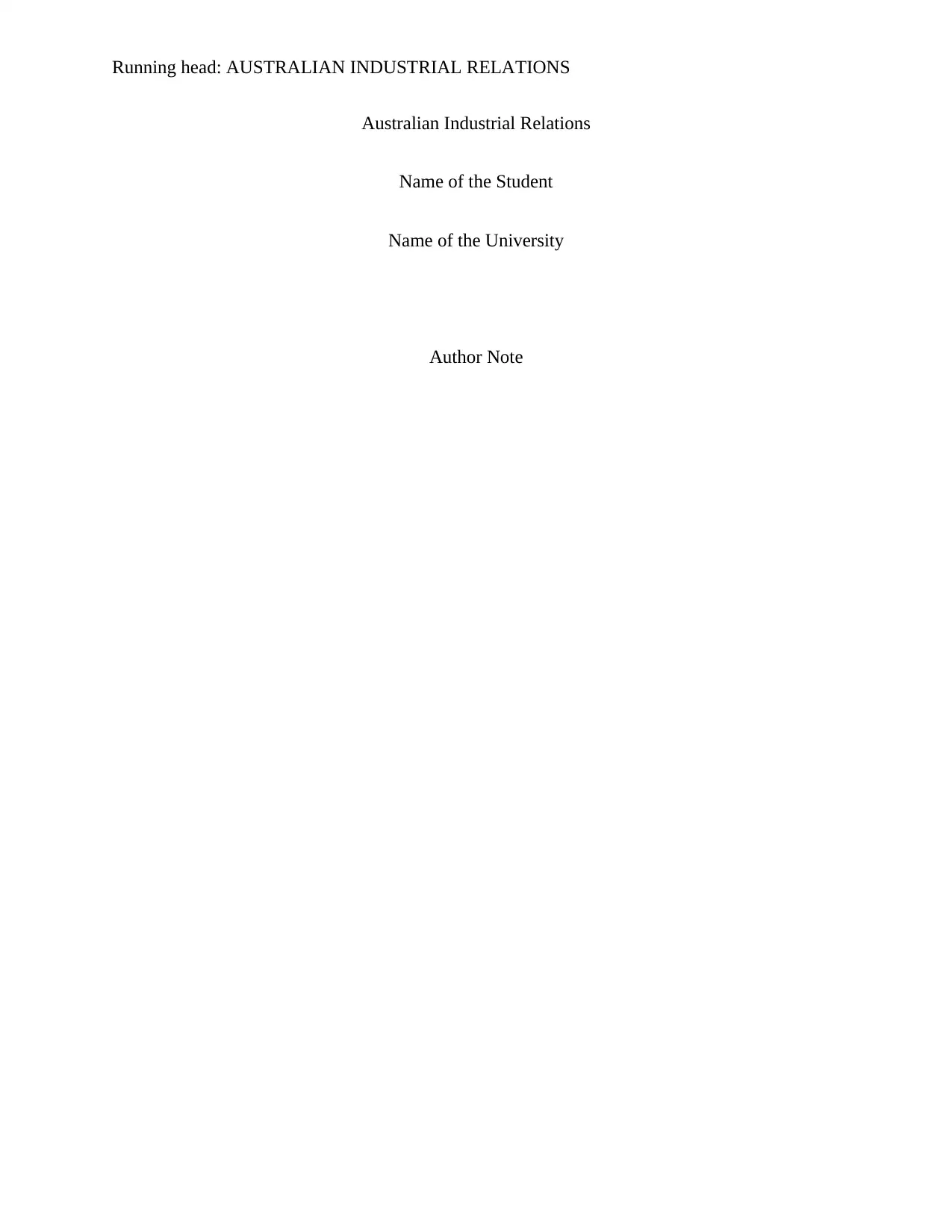
Running head: AUSTRALIAN INDUSTRIAL RELATIONS
Australian Industrial Relations
Name of the Student
Name of the University
Author Note
Australian Industrial Relations
Name of the Student
Name of the University
Author Note
Paraphrase This Document
Need a fresh take? Get an instant paraphrase of this document with our AI Paraphraser
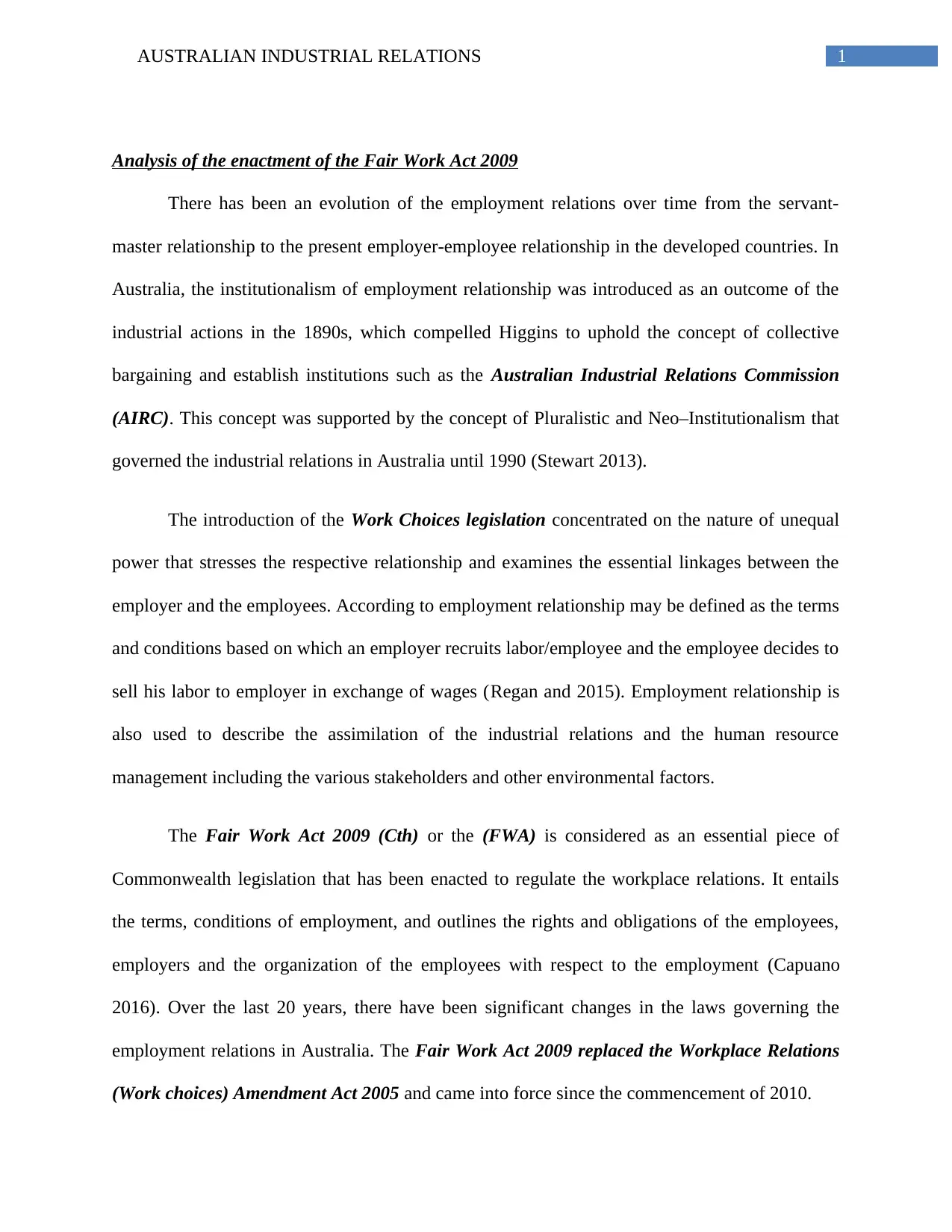
1AUSTRALIAN INDUSTRIAL RELATIONS
Analysis of the enactment of the Fair Work Act 2009
There has been an evolution of the employment relations over time from the servant-
master relationship to the present employer-employee relationship in the developed countries. In
Australia, the institutionalism of employment relationship was introduced as an outcome of the
industrial actions in the 1890s, which compelled Higgins to uphold the concept of collective
bargaining and establish institutions such as the Australian Industrial Relations Commission
(AIRC). This concept was supported by the concept of Pluralistic and Neo–Institutionalism that
governed the industrial relations in Australia until 1990 (Stewart 2013).
The introduction of the Work Choices legislation concentrated on the nature of unequal
power that stresses the respective relationship and examines the essential linkages between the
employer and the employees. According to employment relationship may be defined as the terms
and conditions based on which an employer recruits labor/employee and the employee decides to
sell his labor to employer in exchange of wages (Regan and 2015). Employment relationship is
also used to describe the assimilation of the industrial relations and the human resource
management including the various stakeholders and other environmental factors.
The Fair Work Act 2009 (Cth) or the (FWA) is considered as an essential piece of
Commonwealth legislation that has been enacted to regulate the workplace relations. It entails
the terms, conditions of employment, and outlines the rights and obligations of the employees,
employers and the organization of the employees with respect to the employment (Capuano
2016). Over the last 20 years, there have been significant changes in the laws governing the
employment relations in Australia. The Fair Work Act 2009 replaced the Workplace Relations
(Work choices) Amendment Act 2005 and came into force since the commencement of 2010.
Analysis of the enactment of the Fair Work Act 2009
There has been an evolution of the employment relations over time from the servant-
master relationship to the present employer-employee relationship in the developed countries. In
Australia, the institutionalism of employment relationship was introduced as an outcome of the
industrial actions in the 1890s, which compelled Higgins to uphold the concept of collective
bargaining and establish institutions such as the Australian Industrial Relations Commission
(AIRC). This concept was supported by the concept of Pluralistic and Neo–Institutionalism that
governed the industrial relations in Australia until 1990 (Stewart 2013).
The introduction of the Work Choices legislation concentrated on the nature of unequal
power that stresses the respective relationship and examines the essential linkages between the
employer and the employees. According to employment relationship may be defined as the terms
and conditions based on which an employer recruits labor/employee and the employee decides to
sell his labor to employer in exchange of wages (Regan and 2015). Employment relationship is
also used to describe the assimilation of the industrial relations and the human resource
management including the various stakeholders and other environmental factors.
The Fair Work Act 2009 (Cth) or the (FWA) is considered as an essential piece of
Commonwealth legislation that has been enacted to regulate the workplace relations. It entails
the terms, conditions of employment, and outlines the rights and obligations of the employees,
employers and the organization of the employees with respect to the employment (Capuano
2016). Over the last 20 years, there have been significant changes in the laws governing the
employment relations in Australia. The Fair Work Act 2009 replaced the Workplace Relations
(Work choices) Amendment Act 2005 and came into force since the commencement of 2010.
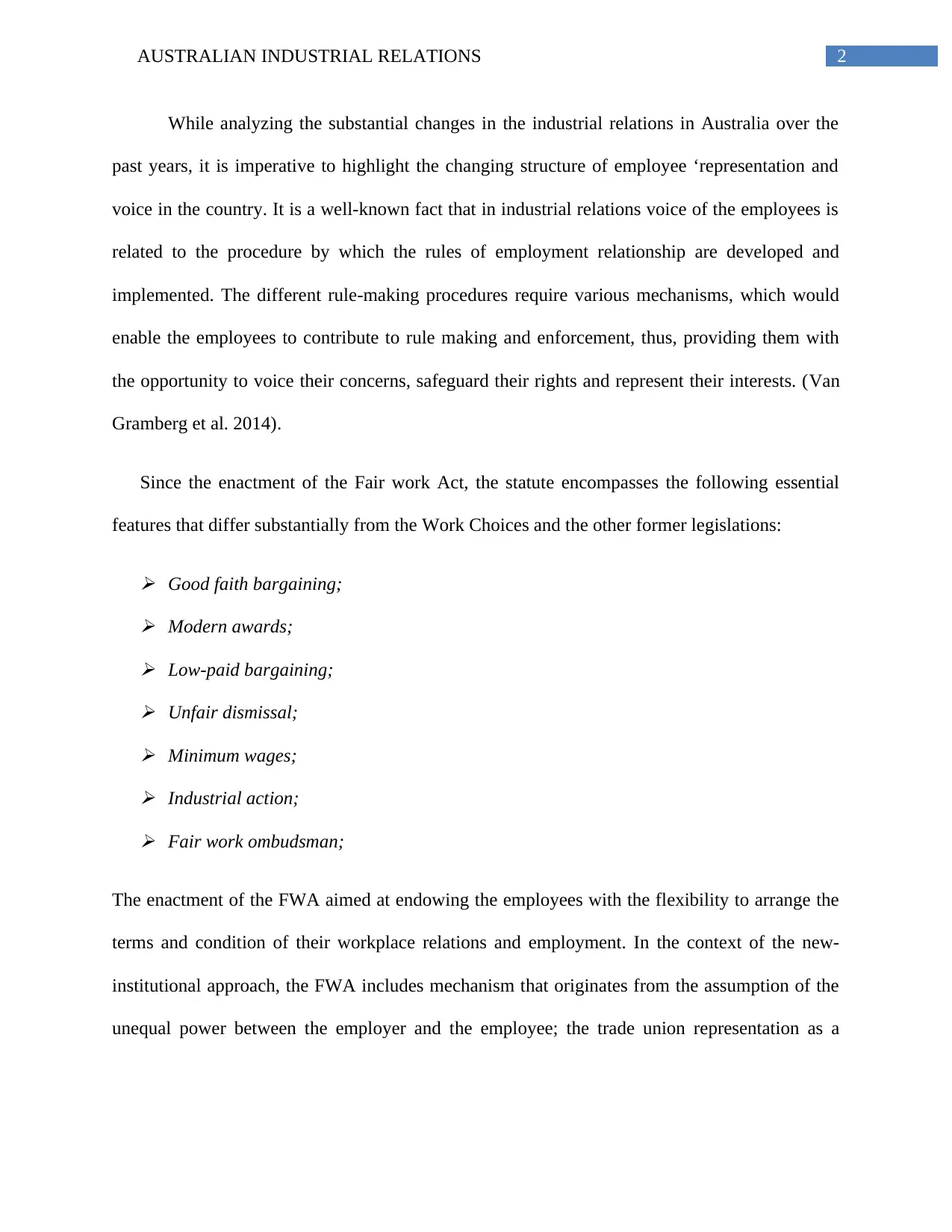
2AUSTRALIAN INDUSTRIAL RELATIONS
While analyzing the substantial changes in the industrial relations in Australia over the
past years, it is imperative to highlight the changing structure of employee ‘representation and
voice in the country. It is a well-known fact that in industrial relations voice of the employees is
related to the procedure by which the rules of employment relationship are developed and
implemented. The different rule-making procedures require various mechanisms, which would
enable the employees to contribute to rule making and enforcement, thus, providing them with
the opportunity to voice their concerns, safeguard their rights and represent their interests. (Van
Gramberg et al. 2014).
Since the enactment of the Fair work Act, the statute encompasses the following essential
features that differ substantially from the Work Choices and the other former legislations:
Good faith bargaining; Modern awards; Low-paid bargaining; Unfair dismissal; Minimum wages; Industrial action; Fair work ombudsman;
The enactment of the FWA aimed at endowing the employees with the flexibility to arrange the
terms and condition of their workplace relations and employment. In the context of the new-
institutional approach, the FWA includes mechanism that originates from the assumption of the
unequal power between the employer and the employee; the trade union representation as a
While analyzing the substantial changes in the industrial relations in Australia over the
past years, it is imperative to highlight the changing structure of employee ‘representation and
voice in the country. It is a well-known fact that in industrial relations voice of the employees is
related to the procedure by which the rules of employment relationship are developed and
implemented. The different rule-making procedures require various mechanisms, which would
enable the employees to contribute to rule making and enforcement, thus, providing them with
the opportunity to voice their concerns, safeguard their rights and represent their interests. (Van
Gramberg et al. 2014).
Since the enactment of the Fair work Act, the statute encompasses the following essential
features that differ substantially from the Work Choices and the other former legislations:
Good faith bargaining; Modern awards; Low-paid bargaining; Unfair dismissal; Minimum wages; Industrial action; Fair work ombudsman;
The enactment of the FWA aimed at endowing the employees with the flexibility to arrange the
terms and condition of their workplace relations and employment. In the context of the new-
institutional approach, the FWA includes mechanism that originates from the assumption of the
unequal power between the employer and the employee; the trade union representation as a
⊘ This is a preview!⊘
Do you want full access?
Subscribe today to unlock all pages.

Trusted by 1+ million students worldwide
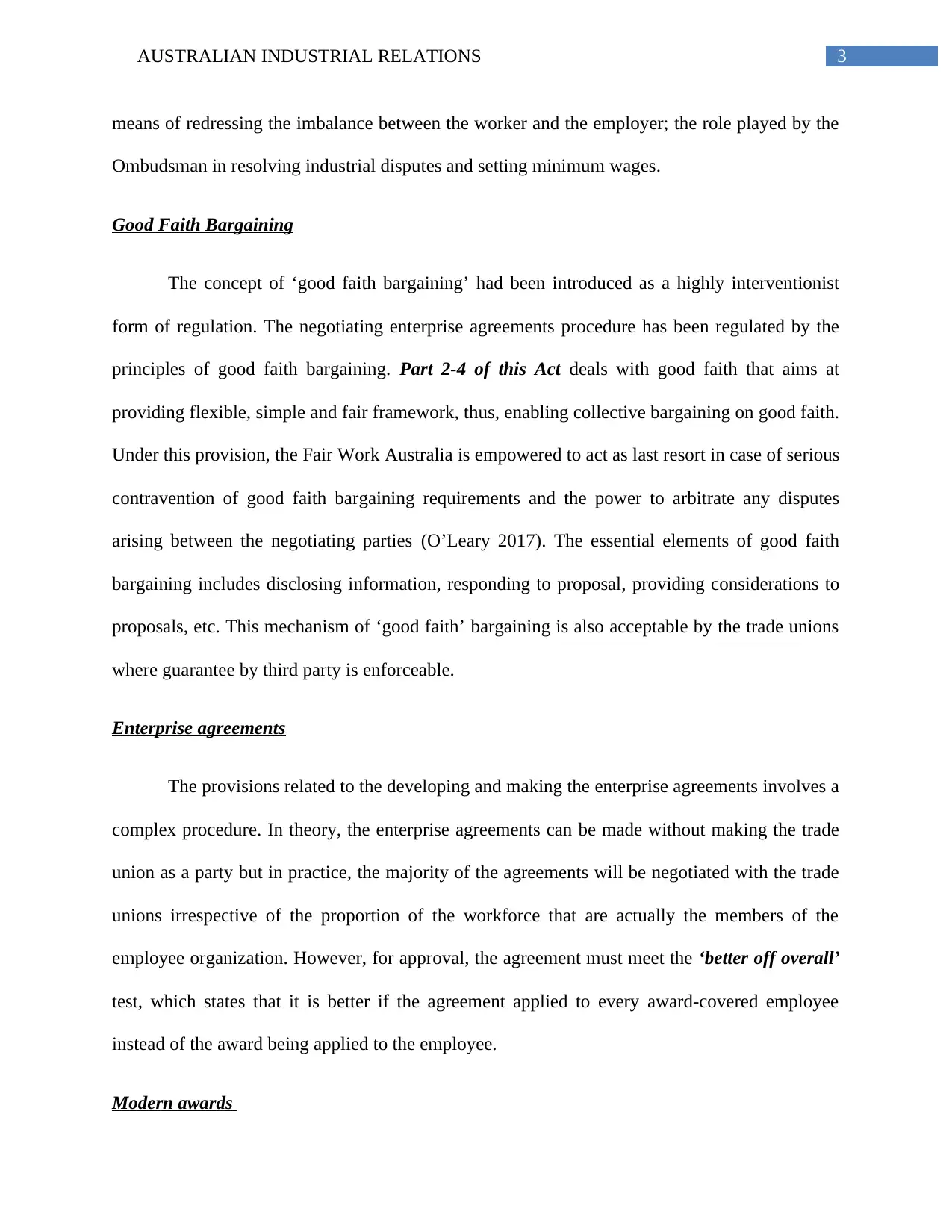
3AUSTRALIAN INDUSTRIAL RELATIONS
means of redressing the imbalance between the worker and the employer; the role played by the
Ombudsman in resolving industrial disputes and setting minimum wages.
Good Faith Bargaining
The concept of ‘good faith bargaining’ had been introduced as a highly interventionist
form of regulation. The negotiating enterprise agreements procedure has been regulated by the
principles of good faith bargaining. Part 2-4 of this Act deals with good faith that aims at
providing flexible, simple and fair framework, thus, enabling collective bargaining on good faith.
Under this provision, the Fair Work Australia is empowered to act as last resort in case of serious
contravention of good faith bargaining requirements and the power to arbitrate any disputes
arising between the negotiating parties (O’Leary 2017). The essential elements of good faith
bargaining includes disclosing information, responding to proposal, providing considerations to
proposals, etc. This mechanism of ‘good faith’ bargaining is also acceptable by the trade unions
where guarantee by third party is enforceable.
Enterprise agreements
The provisions related to the developing and making the enterprise agreements involves a
complex procedure. In theory, the enterprise agreements can be made without making the trade
union as a party but in practice, the majority of the agreements will be negotiated with the trade
unions irrespective of the proportion of the workforce that are actually the members of the
employee organization. However, for approval, the agreement must meet the ‘better off overall’
test, which states that it is better if the agreement applied to every award-covered employee
instead of the award being applied to the employee.
Modern awards
means of redressing the imbalance between the worker and the employer; the role played by the
Ombudsman in resolving industrial disputes and setting minimum wages.
Good Faith Bargaining
The concept of ‘good faith bargaining’ had been introduced as a highly interventionist
form of regulation. The negotiating enterprise agreements procedure has been regulated by the
principles of good faith bargaining. Part 2-4 of this Act deals with good faith that aims at
providing flexible, simple and fair framework, thus, enabling collective bargaining on good faith.
Under this provision, the Fair Work Australia is empowered to act as last resort in case of serious
contravention of good faith bargaining requirements and the power to arbitrate any disputes
arising between the negotiating parties (O’Leary 2017). The essential elements of good faith
bargaining includes disclosing information, responding to proposal, providing considerations to
proposals, etc. This mechanism of ‘good faith’ bargaining is also acceptable by the trade unions
where guarantee by third party is enforceable.
Enterprise agreements
The provisions related to the developing and making the enterprise agreements involves a
complex procedure. In theory, the enterprise agreements can be made without making the trade
union as a party but in practice, the majority of the agreements will be negotiated with the trade
unions irrespective of the proportion of the workforce that are actually the members of the
employee organization. However, for approval, the agreement must meet the ‘better off overall’
test, which states that it is better if the agreement applied to every award-covered employee
instead of the award being applied to the employee.
Modern awards
Paraphrase This Document
Need a fresh take? Get an instant paraphrase of this document with our AI Paraphraser
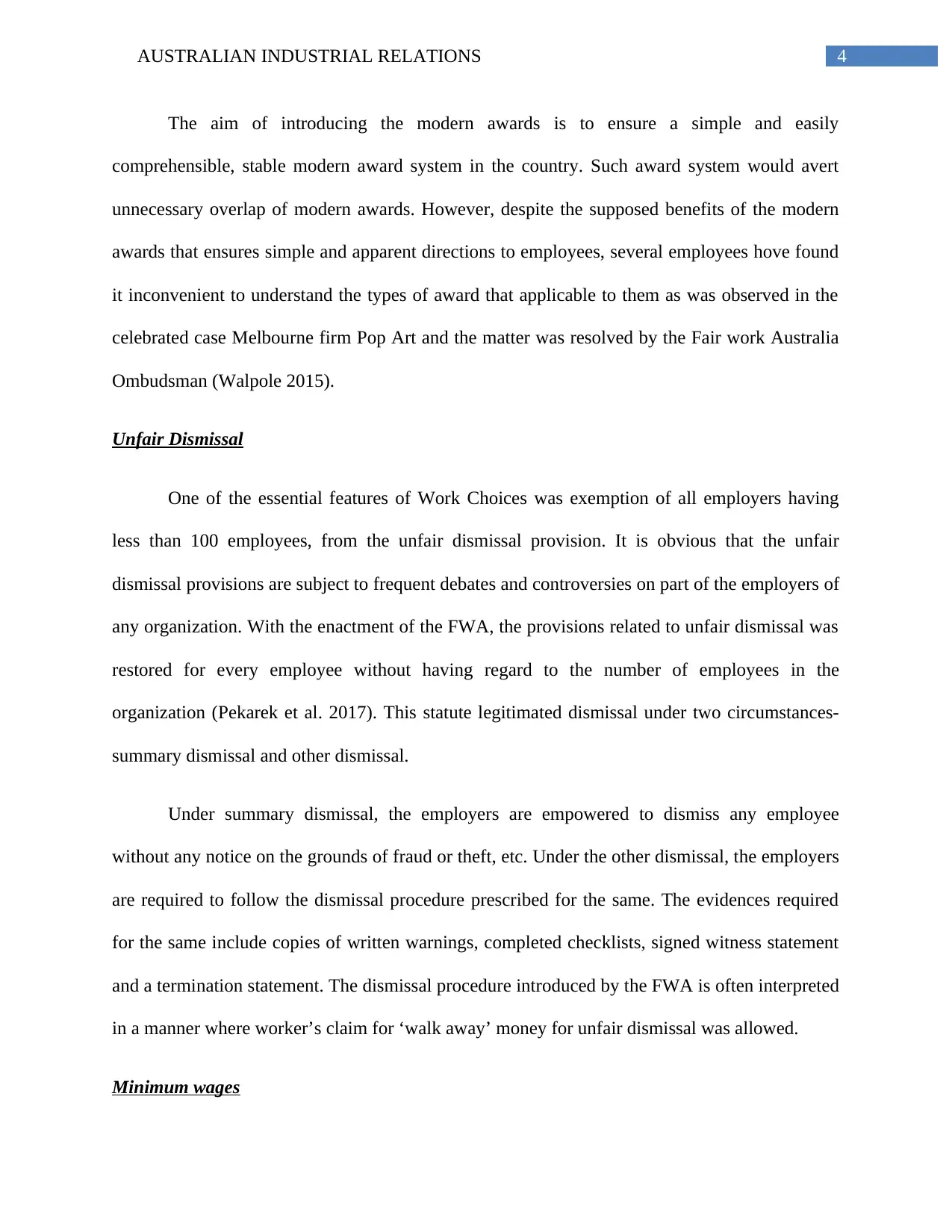
4AUSTRALIAN INDUSTRIAL RELATIONS
The aim of introducing the modern awards is to ensure a simple and easily
comprehensible, stable modern award system in the country. Such award system would avert
unnecessary overlap of modern awards. However, despite the supposed benefits of the modern
awards that ensures simple and apparent directions to employees, several employees hove found
it inconvenient to understand the types of award that applicable to them as was observed in the
celebrated case Melbourne firm Pop Art and the matter was resolved by the Fair work Australia
Ombudsman (Walpole 2015).
Unfair Dismissal
One of the essential features of Work Choices was exemption of all employers having
less than 100 employees, from the unfair dismissal provision. It is obvious that the unfair
dismissal provisions are subject to frequent debates and controversies on part of the employers of
any organization. With the enactment of the FWA, the provisions related to unfair dismissal was
restored for every employee without having regard to the number of employees in the
organization (Pekarek et al. 2017). This statute legitimated dismissal under two circumstances-
summary dismissal and other dismissal.
Under summary dismissal, the employers are empowered to dismiss any employee
without any notice on the grounds of fraud or theft, etc. Under the other dismissal, the employers
are required to follow the dismissal procedure prescribed for the same. The evidences required
for the same include copies of written warnings, completed checklists, signed witness statement
and a termination statement. The dismissal procedure introduced by the FWA is often interpreted
in a manner where worker’s claim for ‘walk away’ money for unfair dismissal was allowed.
Minimum wages
The aim of introducing the modern awards is to ensure a simple and easily
comprehensible, stable modern award system in the country. Such award system would avert
unnecessary overlap of modern awards. However, despite the supposed benefits of the modern
awards that ensures simple and apparent directions to employees, several employees hove found
it inconvenient to understand the types of award that applicable to them as was observed in the
celebrated case Melbourne firm Pop Art and the matter was resolved by the Fair work Australia
Ombudsman (Walpole 2015).
Unfair Dismissal
One of the essential features of Work Choices was exemption of all employers having
less than 100 employees, from the unfair dismissal provision. It is obvious that the unfair
dismissal provisions are subject to frequent debates and controversies on part of the employers of
any organization. With the enactment of the FWA, the provisions related to unfair dismissal was
restored for every employee without having regard to the number of employees in the
organization (Pekarek et al. 2017). This statute legitimated dismissal under two circumstances-
summary dismissal and other dismissal.
Under summary dismissal, the employers are empowered to dismiss any employee
without any notice on the grounds of fraud or theft, etc. Under the other dismissal, the employers
are required to follow the dismissal procedure prescribed for the same. The evidences required
for the same include copies of written warnings, completed checklists, signed witness statement
and a termination statement. The dismissal procedure introduced by the FWA is often interpreted
in a manner where worker’s claim for ‘walk away’ money for unfair dismissal was allowed.
Minimum wages
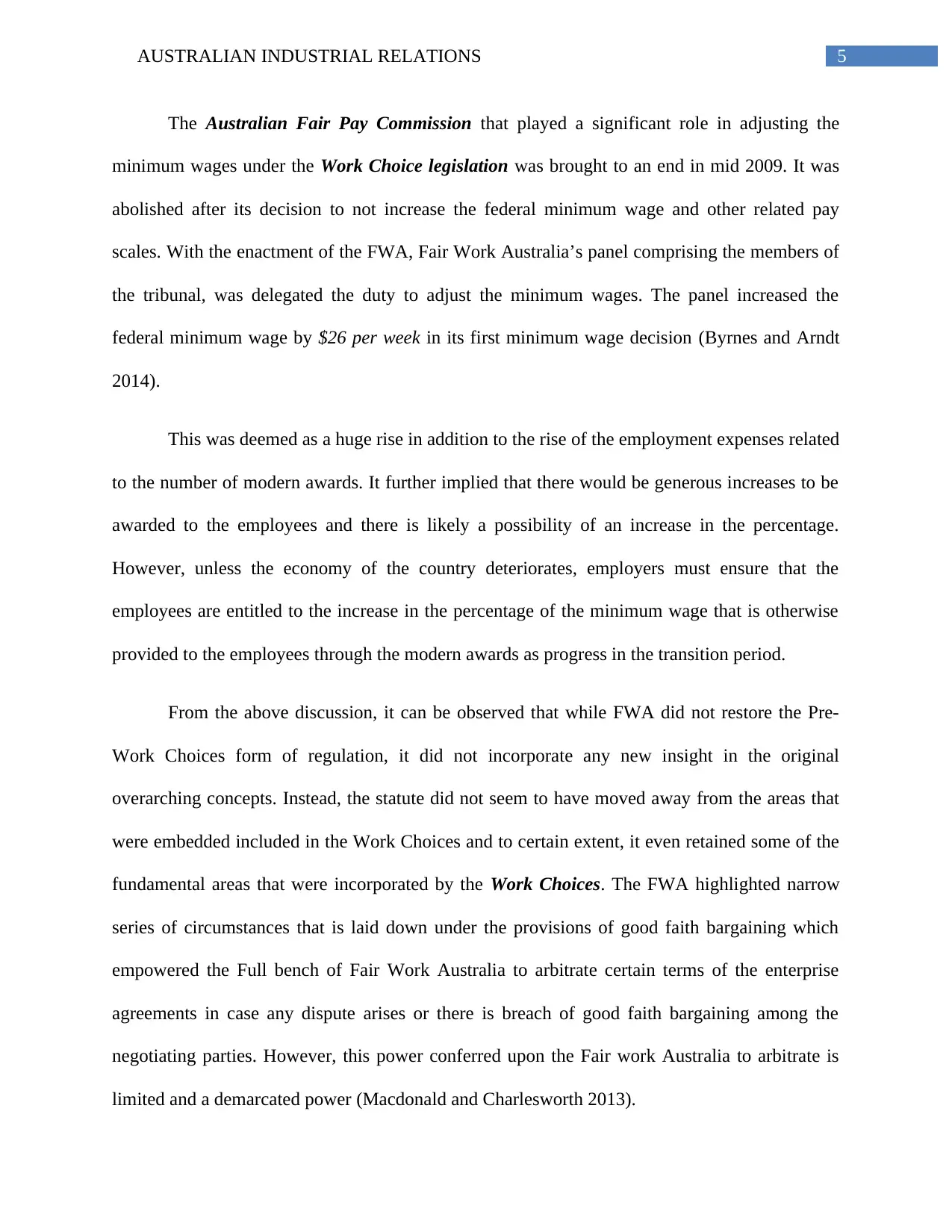
5AUSTRALIAN INDUSTRIAL RELATIONS
The Australian Fair Pay Commission that played a significant role in adjusting the
minimum wages under the Work Choice legislation was brought to an end in mid 2009. It was
abolished after its decision to not increase the federal minimum wage and other related pay
scales. With the enactment of the FWA, Fair Work Australia’s panel comprising the members of
the tribunal, was delegated the duty to adjust the minimum wages. The panel increased the
federal minimum wage by $26 per week in its first minimum wage decision (Byrnes and Arndt
2014).
This was deemed as a huge rise in addition to the rise of the employment expenses related
to the number of modern awards. It further implied that there would be generous increases to be
awarded to the employees and there is likely a possibility of an increase in the percentage.
However, unless the economy of the country deteriorates, employers must ensure that the
employees are entitled to the increase in the percentage of the minimum wage that is otherwise
provided to the employees through the modern awards as progress in the transition period.
From the above discussion, it can be observed that while FWA did not restore the Pre-
Work Choices form of regulation, it did not incorporate any new insight in the original
overarching concepts. Instead, the statute did not seem to have moved away from the areas that
were embedded included in the Work Choices and to certain extent, it even retained some of the
fundamental areas that were incorporated by the Work Choices. The FWA highlighted narrow
series of circumstances that is laid down under the provisions of good faith bargaining which
empowered the Full bench of Fair Work Australia to arbitrate certain terms of the enterprise
agreements in case any dispute arises or there is breach of good faith bargaining among the
negotiating parties. However, this power conferred upon the Fair work Australia to arbitrate is
limited and a demarcated power (Macdonald and Charlesworth 2013).
The Australian Fair Pay Commission that played a significant role in adjusting the
minimum wages under the Work Choice legislation was brought to an end in mid 2009. It was
abolished after its decision to not increase the federal minimum wage and other related pay
scales. With the enactment of the FWA, Fair Work Australia’s panel comprising the members of
the tribunal, was delegated the duty to adjust the minimum wages. The panel increased the
federal minimum wage by $26 per week in its first minimum wage decision (Byrnes and Arndt
2014).
This was deemed as a huge rise in addition to the rise of the employment expenses related
to the number of modern awards. It further implied that there would be generous increases to be
awarded to the employees and there is likely a possibility of an increase in the percentage.
However, unless the economy of the country deteriorates, employers must ensure that the
employees are entitled to the increase in the percentage of the minimum wage that is otherwise
provided to the employees through the modern awards as progress in the transition period.
From the above discussion, it can be observed that while FWA did not restore the Pre-
Work Choices form of regulation, it did not incorporate any new insight in the original
overarching concepts. Instead, the statute did not seem to have moved away from the areas that
were embedded included in the Work Choices and to certain extent, it even retained some of the
fundamental areas that were incorporated by the Work Choices. The FWA highlighted narrow
series of circumstances that is laid down under the provisions of good faith bargaining which
empowered the Full bench of Fair Work Australia to arbitrate certain terms of the enterprise
agreements in case any dispute arises or there is breach of good faith bargaining among the
negotiating parties. However, this power conferred upon the Fair work Australia to arbitrate is
limited and a demarcated power (Macdonald and Charlesworth 2013).
⊘ This is a preview!⊘
Do you want full access?
Subscribe today to unlock all pages.

Trusted by 1+ million students worldwide
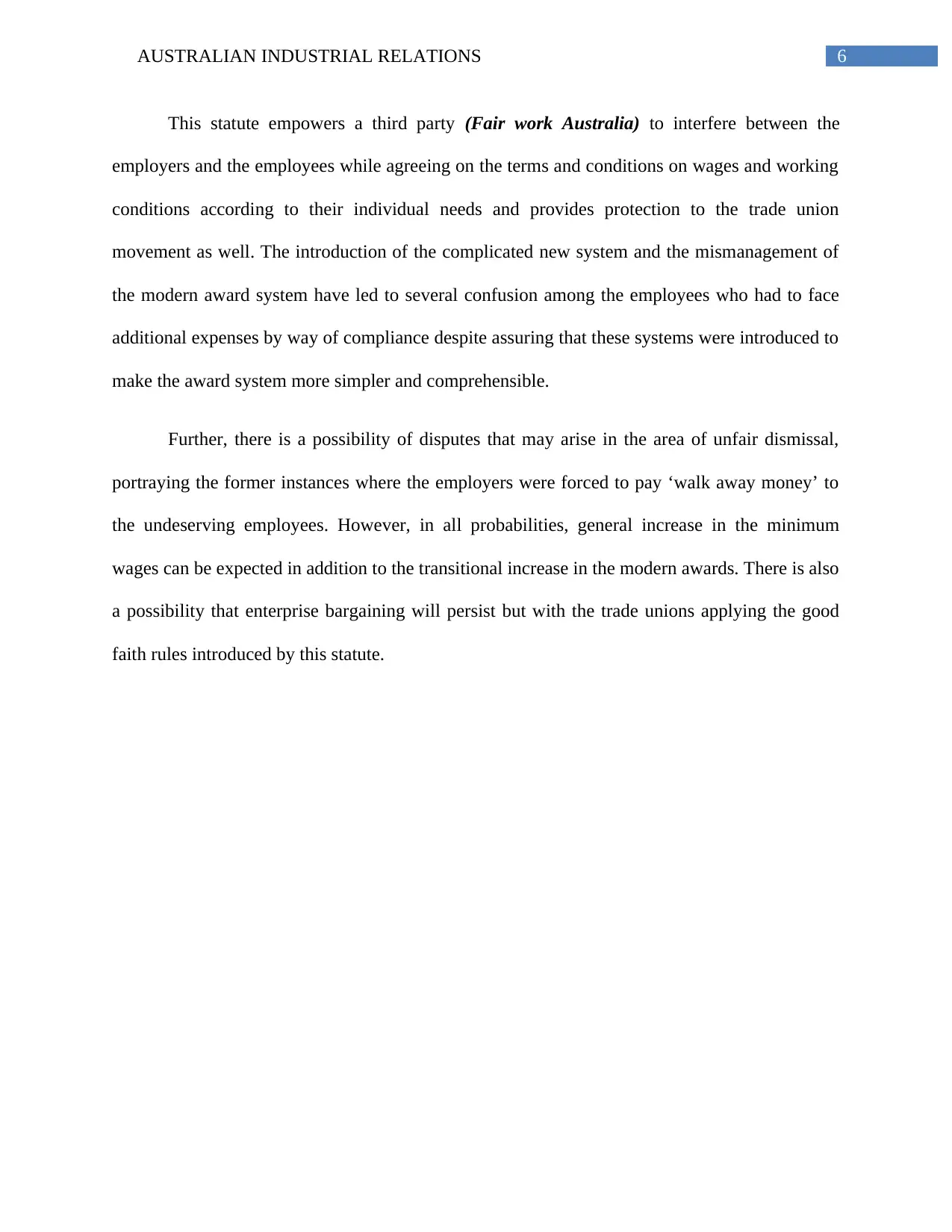
6AUSTRALIAN INDUSTRIAL RELATIONS
This statute empowers a third party (Fair work Australia) to interfere between the
employers and the employees while agreeing on the terms and conditions on wages and working
conditions according to their individual needs and provides protection to the trade union
movement as well. The introduction of the complicated new system and the mismanagement of
the modern award system have led to several confusion among the employees who had to face
additional expenses by way of compliance despite assuring that these systems were introduced to
make the award system more simpler and comprehensible.
Further, there is a possibility of disputes that may arise in the area of unfair dismissal,
portraying the former instances where the employers were forced to pay ‘walk away money’ to
the undeserving employees. However, in all probabilities, general increase in the minimum
wages can be expected in addition to the transitional increase in the modern awards. There is also
a possibility that enterprise bargaining will persist but with the trade unions applying the good
faith rules introduced by this statute.
This statute empowers a third party (Fair work Australia) to interfere between the
employers and the employees while agreeing on the terms and conditions on wages and working
conditions according to their individual needs and provides protection to the trade union
movement as well. The introduction of the complicated new system and the mismanagement of
the modern award system have led to several confusion among the employees who had to face
additional expenses by way of compliance despite assuring that these systems were introduced to
make the award system more simpler and comprehensible.
Further, there is a possibility of disputes that may arise in the area of unfair dismissal,
portraying the former instances where the employers were forced to pay ‘walk away money’ to
the undeserving employees. However, in all probabilities, general increase in the minimum
wages can be expected in addition to the transitional increase in the modern awards. There is also
a possibility that enterprise bargaining will persist but with the trade unions applying the good
faith rules introduced by this statute.
Paraphrase This Document
Need a fresh take? Get an instant paraphrase of this document with our AI Paraphraser
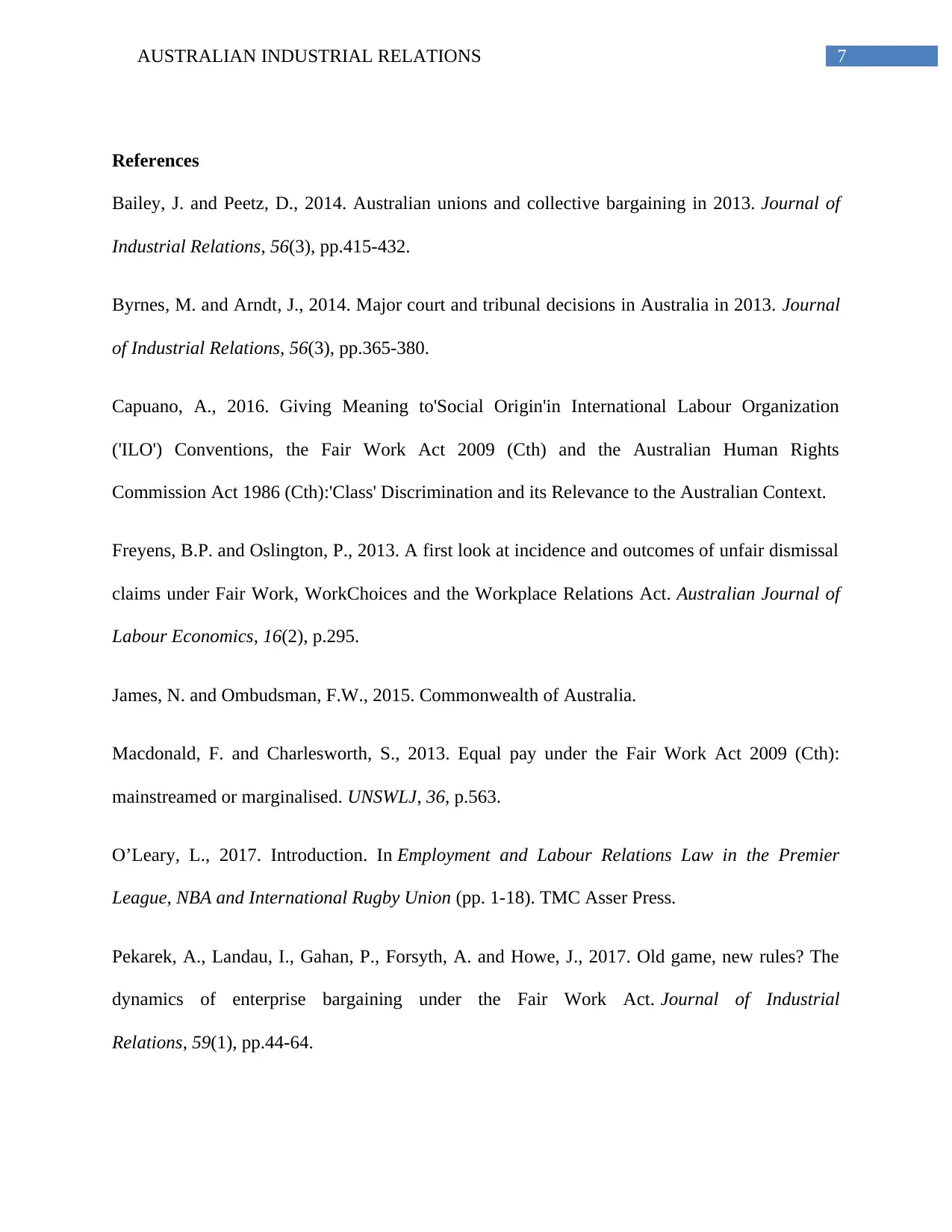
7AUSTRALIAN INDUSTRIAL RELATIONS
References
Bailey, J. and Peetz, D., 2014. Australian unions and collective bargaining in 2013. Journal of
Industrial Relations, 56(3), pp.415-432.
Byrnes, M. and Arndt, J., 2014. Major court and tribunal decisions in Australia in 2013. Journal
of Industrial Relations, 56(3), pp.365-380.
Capuano, A., 2016. Giving Meaning to'Social Origin'in International Labour Organization
('ILO') Conventions, the Fair Work Act 2009 (Cth) and the Australian Human Rights
Commission Act 1986 (Cth):'Class' Discrimination and its Relevance to the Australian Context.
Freyens, B.P. and Oslington, P., 2013. A first look at incidence and outcomes of unfair dismissal
claims under Fair Work, WorkChoices and the Workplace Relations Act. Australian Journal of
Labour Economics, 16(2), p.295.
James, N. and Ombudsman, F.W., 2015. Commonwealth of Australia.
Macdonald, F. and Charlesworth, S., 2013. Equal pay under the Fair Work Act 2009 (Cth):
mainstreamed or marginalised. UNSWLJ, 36, p.563.
O’Leary, L., 2017. Introduction. In Employment and Labour Relations Law in the Premier
League, NBA and International Rugby Union (pp. 1-18). TMC Asser Press.
Pekarek, A., Landau, I., Gahan, P., Forsyth, A. and Howe, J., 2017. Old game, new rules? The
dynamics of enterprise bargaining under the Fair Work Act. Journal of Industrial
Relations, 59(1), pp.44-64.
References
Bailey, J. and Peetz, D., 2014. Australian unions and collective bargaining in 2013. Journal of
Industrial Relations, 56(3), pp.415-432.
Byrnes, M. and Arndt, J., 2014. Major court and tribunal decisions in Australia in 2013. Journal
of Industrial Relations, 56(3), pp.365-380.
Capuano, A., 2016. Giving Meaning to'Social Origin'in International Labour Organization
('ILO') Conventions, the Fair Work Act 2009 (Cth) and the Australian Human Rights
Commission Act 1986 (Cth):'Class' Discrimination and its Relevance to the Australian Context.
Freyens, B.P. and Oslington, P., 2013. A first look at incidence and outcomes of unfair dismissal
claims under Fair Work, WorkChoices and the Workplace Relations Act. Australian Journal of
Labour Economics, 16(2), p.295.
James, N. and Ombudsman, F.W., 2015. Commonwealth of Australia.
Macdonald, F. and Charlesworth, S., 2013. Equal pay under the Fair Work Act 2009 (Cth):
mainstreamed or marginalised. UNSWLJ, 36, p.563.
O’Leary, L., 2017. Introduction. In Employment and Labour Relations Law in the Premier
League, NBA and International Rugby Union (pp. 1-18). TMC Asser Press.
Pekarek, A., Landau, I., Gahan, P., Forsyth, A. and Howe, J., 2017. Old game, new rules? The
dynamics of enterprise bargaining under the Fair Work Act. Journal of Industrial
Relations, 59(1), pp.44-64.
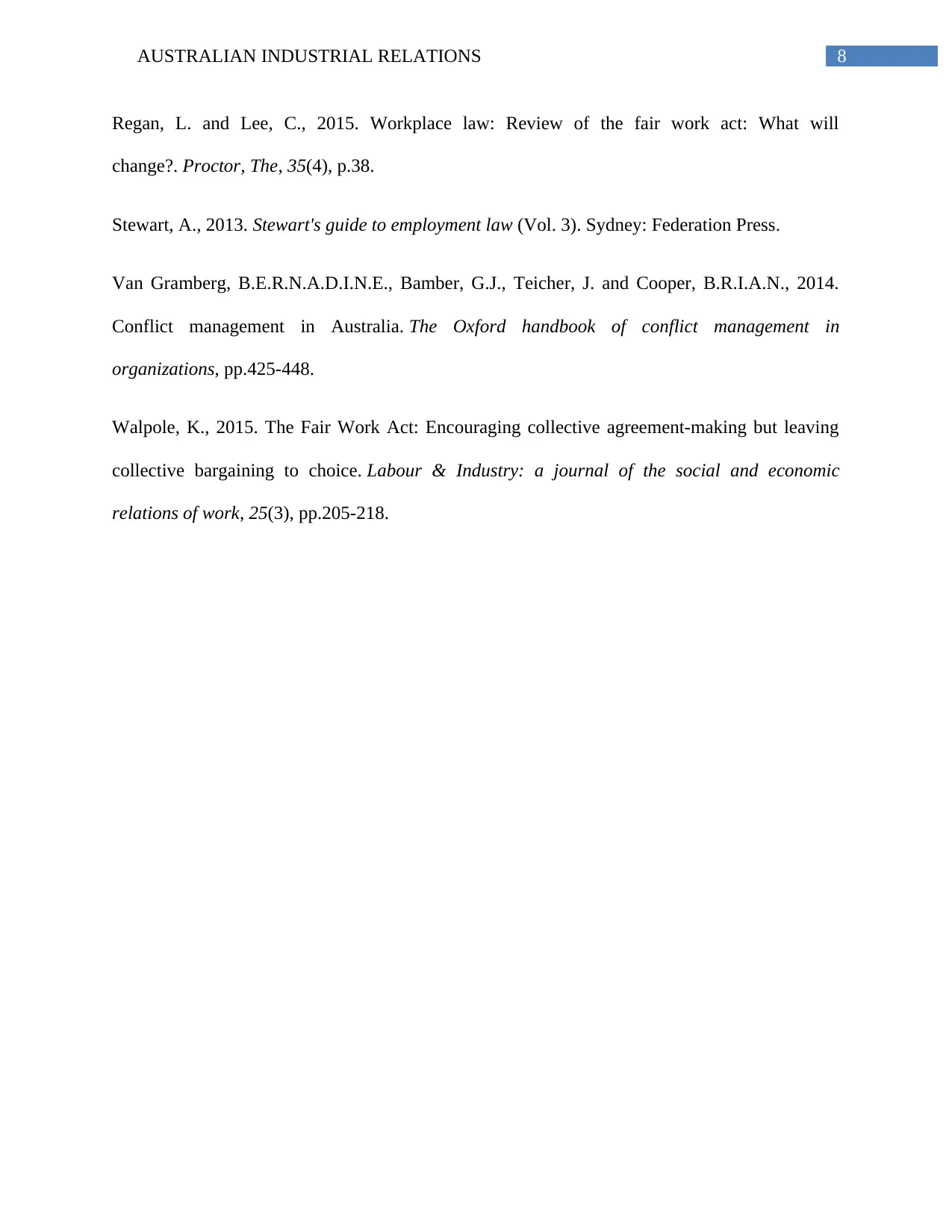
8AUSTRALIAN INDUSTRIAL RELATIONS
Regan, L. and Lee, C., 2015. Workplace law: Review of the fair work act: What will
change?. Proctor, The, 35(4), p.38.
Stewart, A., 2013. Stewart's guide to employment law (Vol. 3). Sydney: Federation Press.
Van Gramberg, B.E.R.N.A.D.I.N.E., Bamber, G.J., Teicher, J. and Cooper, B.R.I.A.N., 2014.
Conflict management in Australia. The Oxford handbook of conflict management in
organizations, pp.425-448.
Walpole, K., 2015. The Fair Work Act: Encouraging collective agreement-making but leaving
collective bargaining to choice. Labour & Industry: a journal of the social and economic
relations of work, 25(3), pp.205-218.
Regan, L. and Lee, C., 2015. Workplace law: Review of the fair work act: What will
change?. Proctor, The, 35(4), p.38.
Stewart, A., 2013. Stewart's guide to employment law (Vol. 3). Sydney: Federation Press.
Van Gramberg, B.E.R.N.A.D.I.N.E., Bamber, G.J., Teicher, J. and Cooper, B.R.I.A.N., 2014.
Conflict management in Australia. The Oxford handbook of conflict management in
organizations, pp.425-448.
Walpole, K., 2015. The Fair Work Act: Encouraging collective agreement-making but leaving
collective bargaining to choice. Labour & Industry: a journal of the social and economic
relations of work, 25(3), pp.205-218.
⊘ This is a preview!⊘
Do you want full access?
Subscribe today to unlock all pages.

Trusted by 1+ million students worldwide

9AUSTRALIAN INDUSTRIAL RELATIONS
1 out of 10
Related Documents
Your All-in-One AI-Powered Toolkit for Academic Success.
+13062052269
info@desklib.com
Available 24*7 on WhatsApp / Email
![[object Object]](/_next/static/media/star-bottom.7253800d.svg)
Unlock your academic potential
Copyright © 2020–2025 A2Z Services. All Rights Reserved. Developed and managed by ZUCOL.





